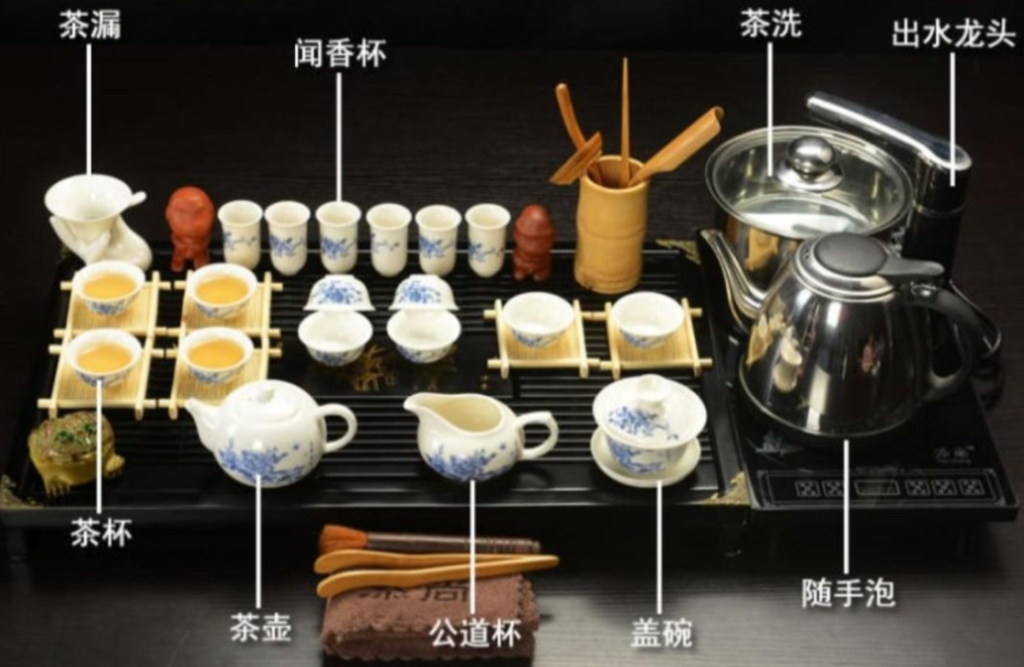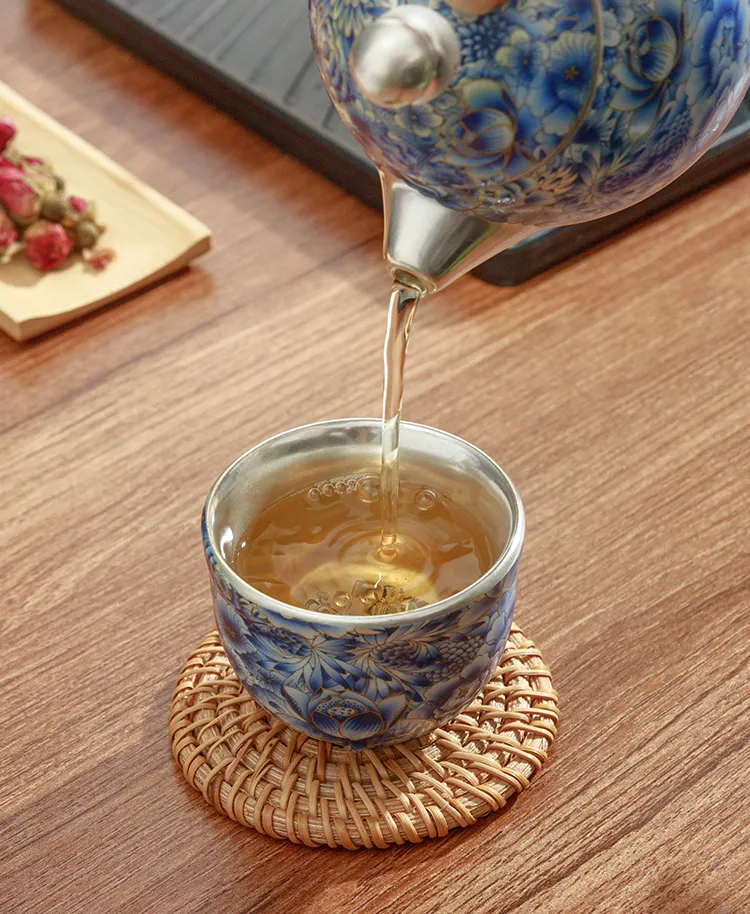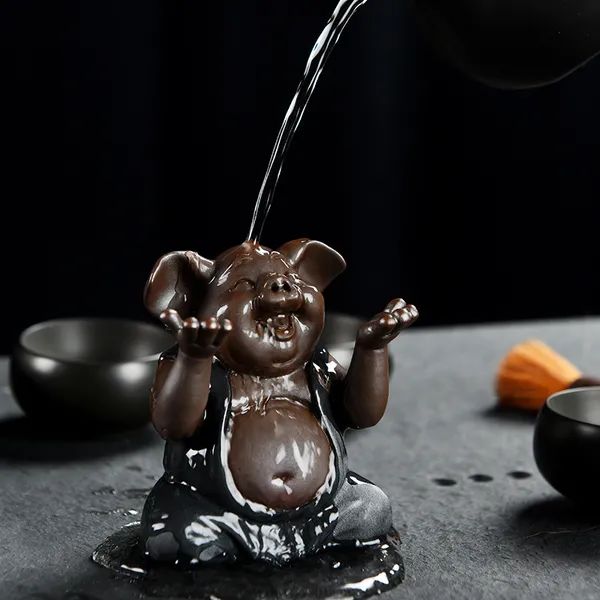Just as fish cannot live without water. No matter how good the tea leaves are, without a set of good tea sets, the flavor and aroma of the tea cannot be fully realized. A complete tea set consists of multiple components, each with its unique function. Below, we will introduce all the tea set components one by one. Get to know all the names of tea set components at once and you won’t have to look elsewhere anymore.
I. Names of Each Component of Tea Sets 1. Gaiwan: Used for brewing tea leaves. It is usually composed of a bowl, a lid, and a base, and is also called the Three Talents Bowl. 2. Gongdao Cup: Used to evenly distribute the tea soup to ensure that each tea taster gets the same concentration of tea soup. 3. Glass: Used to hold the tea soup, making it easy to observe the tea leaves dancing in the water. 4. Teacup for Tasting: A small cup used for tasting the tea soup. 5. Aroma Cup: A small cylindrical cup for savoring the aroma of the tea leaves. 6. Tea Holder: An implement like a small plate or dish used to temporarily hold the tea leaves. 7. Tea Spoon: Used to pick up tea leaves from the tea storage container or the tea holder. 8. Tea Needle: Used to unclog the strainer of the teapot. 9. Tea Strainer (placed on the teapot): Generally placed on the mouth of the teapot to prevent the tea leaves from scattering. It is used for granular teas such as Tieguanyin. 10. Tea Filter (placed on the gongdao cup): Placed on top of the gongdao cup to facilitate filtering out tea dregs and keep the tea soup clean. 11. Tea Tongs: Used to pick up teacups to avoid burning hands. It is usually used when three or four people are sitting around a tea tray drinking tea. 12. Tea Saucer: Placed at the bottom of the teacup to hold the teacup. Since it is not recommended to touch the rim of the teacup with hands when holding it, holding the tea saucer is a good choice. 13. Tea Tray: Used to place tea sets and collect tea water. 14. Tea Sea: Used for multiple people to share the tea soup. 15. Teapot: Used for brewing tea leaves, with the same function as the gaiwan, but with a more elegant shape and a handle. 16. Pot Stand: Used to catch the water droplets at the bottom of the teapot, equivalent to the base of the pot. 17. Water Basin: Used to hold waste water. 18. Incense Burner: Used to burn aromatherapy to create a tea-tasting atmosphere. 19. Tea Towel: Used to wipe tea sets. 20. Tea Mat: Placed under the tea set to prevent slipping and insulate heat. 21. Tea Chest: Used to store tea leaves and tea sets. 22. Tea Bowl: Another form of teacup for tasting, generally in the shape of a rice hat, and some are similar to regular eating bowls. 23. Tea Cup (Tea Zhǎn): There is the Jianzhan, an ancient type of teacup. 24. Tea Sieve: Just a small sieve, which can be used when there are tea dregs in dry tea. 25. Tea Spoon Holder: Used to store the Six Gentlemen of Tea Ceremony, something similar to a pen holder. 26. Tea Caddy: Used to store tea leaves. II. Introduction to Some Terms 1. Tea Set Set: A set that includes various tea sets. 2. Tea Culture: Includes tea ceremony, tea ethics, tea spirit, tea couplets, tea books, tea sets, tea recipes, tea poems, tea paintings, tea studies, tea stories, tea art, etc. All these combined make up tea culture. Even tea knowledge belongs to this culture. 3. Tea Set Accessories: Such as tea set cleaning brushes, tea set repair tools, etc. 4. Tea Art Performance Equipment: Such as tea art costumes, tea art background music, etc.Tea Culture Books: Books that introduce tea culture and tea art.
Tea Art Training Institutions: Institutions that provide tea art training, tasting, and performance services. Six Gentlemen of Tea Ceremony: Tea scoop, tea needle, tea strainer, tea tongs, tea spoon, and tea caddy. Drinking Tea: Generally means having tea, but the name varies in different places. Tea Music: Usually refers to the music played while drinking tea. Currently, I know the music of Wu Na, Zhao Zheng, etc. III. Temporary or Outdoor Camping Utensils Quick Guest Cup: A portable tea set, one set with three pieces, suitable for making tea quickly. Floating Cup: A manual tea-pouring cup with a strainer, a portable tea set. Automatic Tea-making Machine: A machine that automatically brews tea, suitable for use in the office or outdoors. III. Materials and Advantages of Tea Sets Ceramics: Ceramic tea sets have elegant colors and good heat preservation properties, which can well preserve the aroma and taste of tea. Purple Clay: Purple clay tea sets have good air permeability, which can make the tea soup more mellow and are suitable for brewing oolong tea, Pu-erh tea, etc. Glass: Glass tea sets have high transparency, which is convenient for observing the changes of tea leaves in water and are suitable for brewing green tea, black tea, etc. Stainless Steel: Stainless steel tea sets are durable and not easy to rust, suitable for outdoor or office use and easy to clean. Bamboo: Bamboo tea sets have good thermal conductivity, are suitable for brewing various types of tea, and have a unique natural flavor. Wood: Wooden tea sets have good heat preservation properties, comfortable hand feeling, and can add fun to tea tasting. They are suitable for brewing Pu-erh tea, dark tea, etc. Silver: Silver tea sets have good thermal conductivity and antibacterial properties, which can improve the quality of the tea soup and are suitable for high-end tea art performances. Plastic: Plastic tea sets are lightweight and affordable, suitable for daily use, especially during outdoor activities. IV. Conclusion Tea sets come in different materials and shapes, each suitable for different scenarios and personal preferences. When choosing a tea set, not only personal preferences but also the characteristics of the tea should be considered. A good tea set may better present the original flavor of the tea and make it easier to brew a good cup of tea. As the saying goes, if you want to do a good job, you must first sharpen your tools.


